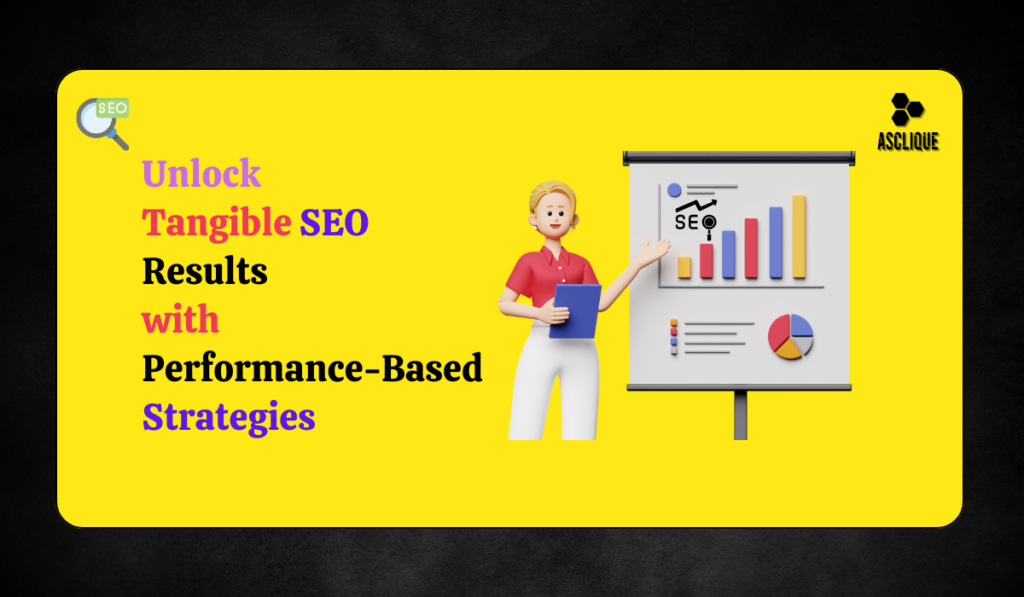Digital competition is so fierce and has pushed companies to bring in measurable results through tactics. The performance-based SEO, though, has now changed the game for designing measurable and determined results according to the business motive. This article will highlight some of the fundamental characteristics of performance-based search engine optimization, how it works. And the reason it becomes an integral part of modern-day strategies for digital marketing.
What is Performance-Based SEO?
Performance SEO tends to locate itself lent against a tangible business result like bringing more traffic to the site, improved rankings in search engines, lead generation, or sales conversions. Performance SEO stands in contrast to old-time SEO that concerns itself solely with how well a site does up ranking ladders as well as backlinks. Performance-based SEO aligns goals with broader business objectives and can value all work within measurable terms. It is content based and result oriented.
Characteristics
- Result Oriented: This means a focus clearly on business outcomes.
- Transparent Metrics: Would Track Clear Measurable KPIs (Key Performance Indicators) like conversion rates, lead generation, as well as sales.
- Cost-Efficient: Pay-per-click basis for an advertiser or a business in performance delivery instead of needing to incur a flat service fee or hourly payment.
Benefits
- Increased ROI: By focusing on results, businesses only pay for the performance achieved. This ensures that companies allocate marketing budgets efficiently, maximizing returns.
- More Accountability: The agencies and SEO specialists then become accountable for delivering results under a performance-based model, hence making them more invested in the success of the campaign. It makes for reliable conclusions.
- Clear Metrics and Reporting: Performance-based SEO relies on clear and measurable actionable metrics; analytics, thus, allow businesses to get the naked truth on how these activities on SEO impacts their bottom lines.
- Tailored to Corporate Goals: This is how SEO campaigns are customized in terms of goals in business lead generation, sales increase, and more exposure for brands.
Challenges
While performance-based SEO offers numerous advantages, it also comes with its own set of challenges:
- Long Lasting Effects: SEO is a long-term strategy. Paid advertisements render instant results, while a tangible improvement in performance via SEO entails hard work and patience.
- Algorithm Changes: Search engine algorithms are always changing. Some technique or trick may work today but would be totally useless tomorrow. The objective is to stay plugged in to new trends and modify strategies accordingly.
- Dependence on External Factors: Search engine results can be influenced by external factors such as competition, changes in search behavior, and seasonality, which can make it difficult to predict exact performance outcomes.
- Competitor Actions: Results can be affected when competitors escalate their SEO efforts or make aggressive moves. Monitoring and modifying your tactics to remain competitive is a must.
How Does Performance-Based SEO Work?
Performance-based SEO revolves around setting clear objectives and measurable goals. Here’s how it works:
Establish Business Objectives And Kpis Before Starting SEO Activity
Before commencing any SEO activity, it is important to understand the primary business goal such as generating organic traffic, generating leads, or increasing e-commerce sales. Pertaining to these business goals, performance-based SEO becomes a function of identifying appropriate KPIs.
Research and Strategy Formulation
Once the objectives are set, SEO authorities conduct extensive market, competitor, and keyword research. This part brings about the strategy of developing the most valuable opportunity which one should pursue.
Optimization and Implementation
In this case, the whole SEO team would be implementing an on-page and off-page optimization technique; that is web structuring, high-quality content, user experience (UX) optimizing, and attaining backlinks. All these executions would focus on measurable performance metrics.
Continuous Monitoring and Reporting
Continuous monitoring is a must-have in terms of performance-based SEO. The tracking of real-time results by SEO experts will ensure that your campaigns go to plan relative to achieving the end defined KPIs. Thus, transparent reporting shows the way in which real business changes result from activity in an SEO sense.
Optimization Based on Results
As performance data is gathered, the strategy is fine-tuned to maximize results. For example, if certain keywords are delivering better results, more resources can be allocated to capitalize on that opportunity.
Key Performance Indicators (KPIs)
To measure the effectiveness of a performance-based SEO campaign, it’s essential to track relevant KPIs that directly align with the business goals. Some of the most common KPIs include:
Growth in Organic Traffic
The amount of organic traffic a website enjoys is indeed one of the vital performance indicators in SEO. Therefore, a regular increase in the number of visitors to the website will be the ultimate outcome of an effective SEO campaign.
Keyword Rankings
One way for a business to evaluate its SEO performance in terms of visibility in search engine results is to track the ranking of its target keywords. The rankings would likely change- sometimes improve- as one or more of the competitive keywords start driving up traffic, visibility, and source accounts.
Conversion
In the end, SEO aims to attract traffic, but relevant traffic that will then convert into customers. It is also important to keep track of conversions, like the ones happening on submissions, payments made, or inquiries to check the ROI.
Click Through Rate (CTR)
A higher CTR from search engine results means that the SEO strategy could bring more relevant traffic to a site by providing more appealing and relevant descriptions, titles, and snippets.
Bounce Rate
A high bounce rate could indicate that the landing page is not drawing users in. Which is not matching their intent. Monitoring and working to reduce bounce rates are critical for overall efficacy enhancement in SEO.
The Future of Performance-Based SEO
The way in which performance-based search engine optimization is changing with digital marketing is now becoming part and parcel of overall marketing strategies for businesses. Here, improvement in AI, machine learning, and data analytics will make SEO campaigns more accurate and result-focused, directly allowing businesses to see real-time outcomes and modify accordingly.
Major Trends to Watch Out
- AI-Powered SEO Tools: Automation tools powered by artificial intelligence will help the SEO professional identify opportunities, predict trends, and measure performance more precisely.
- User Experience (UX) Optimization: Performance-based SEO is likely to shift toward improving these elements as search engines increasingly factor UX signals like mobile usability and page speed into their equation.
- Voice Search Optimization: Performance-based SEO practices will eventually make way for optimizing for voice queries because of the increasing demand for voice searches.
Conclusion
Performance-based SEO is changing how businesses think about search engine optimization because it provides tangible and measurable outcomes; therefore, businesses can be assured that their investment in SEO actually adds value to the business and aligns with bigger business goals. Like anything, it has its challenges, but increased ROI, improved accountability and personalization are some of the benefits for any digital marketing strategy. Businesses can experience sustainable growth and a competitive advantage in their market, when they adapt to the evolving landscape of search engines and continually optimize their SEO efforts using the performance data they collect.
FAQs
Compare and contrast traditional SEO and performance-based SEO.
Traditional SEO maximizes rankings and backlinks. Businesses realize certain outcomes: conversion, sales, etc., by making payments for results achieved.
How soon can I see results from performance-based SEO?
It typically takes anywhere from 3 to 6 months for results to appear, unfortunately, depending on several competitive and industrial factors. Improvements would, however, be witnessed incrementally as optimization progresses.
How do I determine which KPIs apply to my SEO campaign?
The KPIs should directly relate to your goals—organic traffic for awareness, conversions for lead generation, and sales for e-commerce. Settle on metrics relevant to your own business goals.
Is performance-based SEO valid for small businesses?
Yes, it is a good strategy for small businesses because they can pay only for what they can prove has worked and ramp up their efforts as required.
What happens if my campaign does not bring in any results?
Typically, once the campaign goes off-track, the SEO vendor shall then readjust its strategy and optimize its other activities accordingly to attain performance improvements toward achieving the goals.

